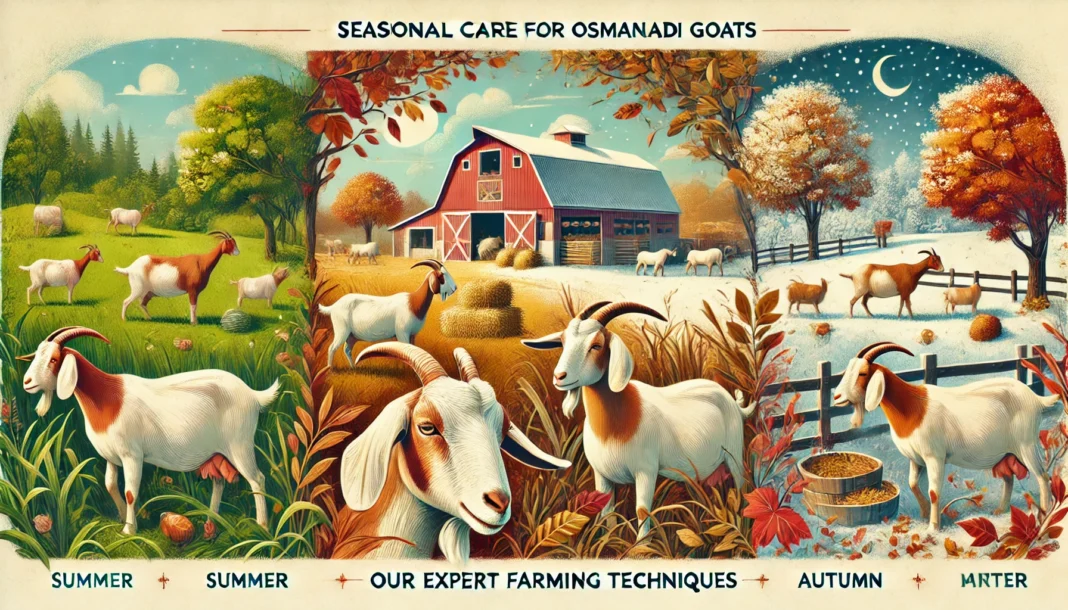Seasonal Care for Osmanabadi Goats
Importance of Seasonal Care
We understand that seasonal care is vital for the health and productivity of Osmanabadi goats. Proper management across different seasons not only enhances their welfare but also ensures better yields in terms of milk and meat.
During harsh weather conditions, goats can develop health issues if not cared for appropriately, impacting their overall productivity. Seasonal adjustments in our management techniques allow us to provide more suitable environments and nutrition for our goats, ultimately benefiting our farming outcomes.
Impact of Weather on Goats
Weather conditions significantly influence the health and behavior of Osmanabadi goats. These animals exhibit remarkable adaptability, but extreme temperatures, whether hot or cold, can create challenges. Here is a brief overview of how different weather conditions can affect our goats:
| Weather Condition | Impact on Goats |
|---|---|
| Hot Weather | Increased risk of heat stress; reduced appetite; dehydration |
| Cold Weather | Risk of hypothermia; increased nutritional needs for energy |
| Rainy Season | Higher chances of illness; mud and wet conditions can affect hooves |
In hot climates, goats, including Osmanabadi types, exhibit various adaptations that allow them to thrive despite challenging conditions. Their low body mass and efficient grazing behavior enable them to minimize water and food requirements. They often consume tree leaves and shrubs, which provide a reliable food source during dry spells.
Understanding these impacts helps us adjust our osmanabadi goat feeding strategies and implement targeted care practices. For instance, providing adequate shade and water during hot months is crucial. In colder weather, we need to ensure proper shelter to protect our goats from the elements, which can be achieved through effective osmanabadi goat shelter design.
Overall, by recognizing the effects of seasonal changes on our goats, we can take proactive measures to ensure their health and productivity in varying weather conditions. This understanding is a key component of successful osmanabadi goats farming techniques.
Farming Techniques for Health Management
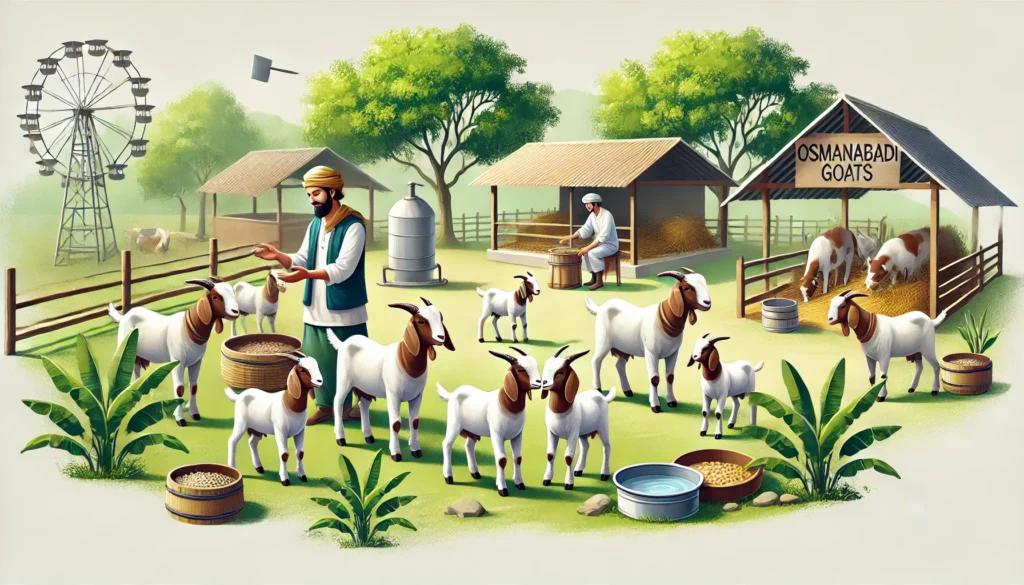
Taking care of our Osmanabadi goats goes beyond providing food and shelter; it entails a consistent focus on their health and well-being. Our approach to health management is aimed at boosting productivity while ensuring the overall health of our livestock.
Essential Health Practices
We adopt several essential health practices to enhance the productivity of our goats. One of the key aspects is implementing biosecurity measures. This includes regular cleaning and disinfection of equipment and facilities to minimize the risk of disease outbreaks.
We also adhere to a strict vaccination schedule to protect our goats against common diseases. Keeping records of vaccinations helps us stay organized and ensures that each goat receives timely healthcare. Below is a table summarizing some common vaccines and their purposes:
| Vaccine | Purpose |
|---|---|
| CD&T | Protects against Clostridial diseases and Tetanus |
| Pasteurella | Prevents Pneumonia and respiratory diseases |
| Enterotoxemia | Prevents overeating disease caused by Clostridium perfringens Type D |
In addition to vaccinations, we prioritize parasite control. Regular deworming practices are crucial for preventing infestations that can negatively impact our goats’ health.
Disease Prevention Strategies
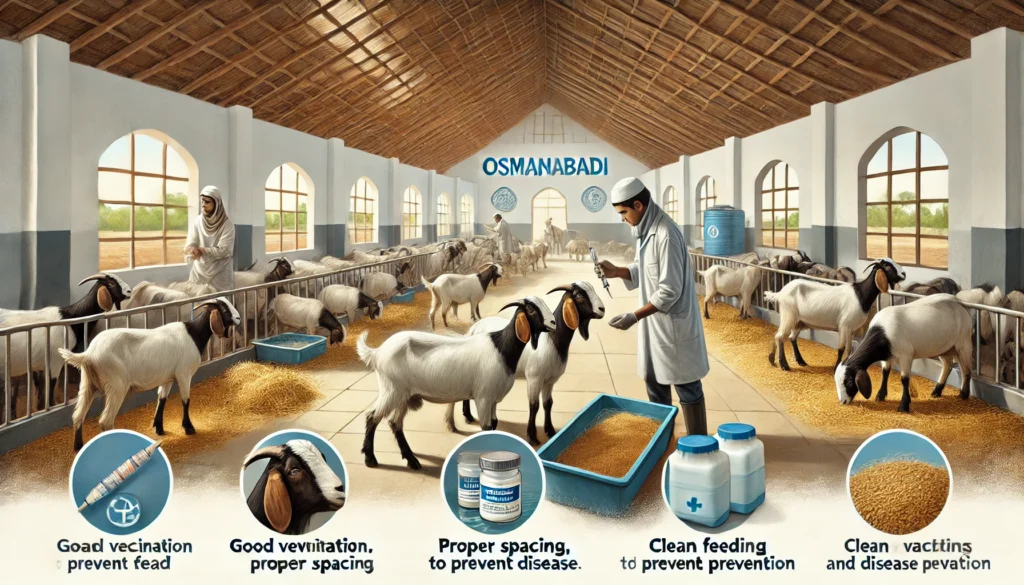
Understanding the common diseases that affect Osmanabadi goats, such as Coccidiosis, Enterotoxaemia, and Pneumonia, helps us implement effective prevention strategies. We utilize specific treatments tailored to these diseases, including antibiotics, vaccines, and dietary adjustments.
For instance, Coccidiosis requires timely treatment with appropriate medications, while Enterotoxaemia prevention involves ensuring our goats receive the correct vaccinations. It is also essential to maintain good nutrition through proper feeding strategies to boost their immune systems. For more details on feeding practices, check our article on osmanabadi goat feeding strategies.
In our goat farm, we manage diseases not just through treatment but also by adopting preventive measures. Creating a healthy living environment through proper housing and cleanliness reduces the chances of illnesses spreading. We often refer to our osmanabadi goat shelter design guidelines to ensure that our goats are comfortable and stress-free.
By focusing on these health management techniques and implementing them diligently, we aim to keep our Osmanabadi goats healthy and productive. Regular veterinary care is also part of our routine, ensuring that any health issues are addressed promptly. For insights into our vaccination protocols, visit our article on osmanabadi goat vaccination schedule.
Mitigating Heat Stress in Goats
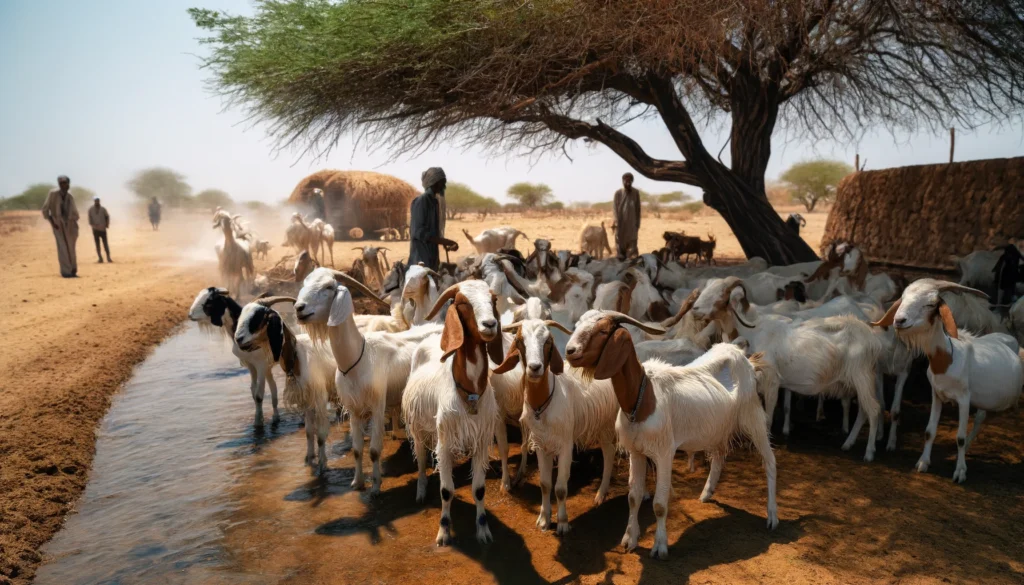
Heat stress is a significant concern for us as Osmanabadi goat farmers, particularly during the hot months. Understanding how heat affects our goats and implementing effective management practices is essential for maintaining their health and productivity.
Understanding Heat Stress Effects
When goats experience heat stress, it can lead to several adverse physiological responses. These include:
- Elevated body temperature
- Increased respiration rate
- Heightened rectal temperature
Under heat stress conditions, goats may reduce their feed intake significantly, resulting in decreased body weight and lower daily dry matter intake. In fact, feed intake may decrease by up to 30% when temperatures rise excessively. Additionally, increased water intake becomes crucial as it aids in heat dissipation through sweating and panting during hot weather.
Goats also exhibit specific behavioral changes when under stress, such as:
- Standing still for longer periods
- Seeking shade more often
- Dampening body surfaces to cool down
These responses can be worrying as heat stress not only impacts our goats’ growth and weight gain but also negatively affects milk production and quality. Research shows that high temperatures can cause a decline in milk yield due to reduced food and water consumption.
Here’s a summary of some impacts of heat stress:
| Effect of Heat Stress | Impact |
|---|---|
| Reduced feed intake | Up to 30% decrease |
| Increased water intake | Exponential increase |
| Reduced milk production | Decline in quality and quantity |
| Compromised immune response | Increased disease susceptibility |
Managing Heat Stress on the Farm
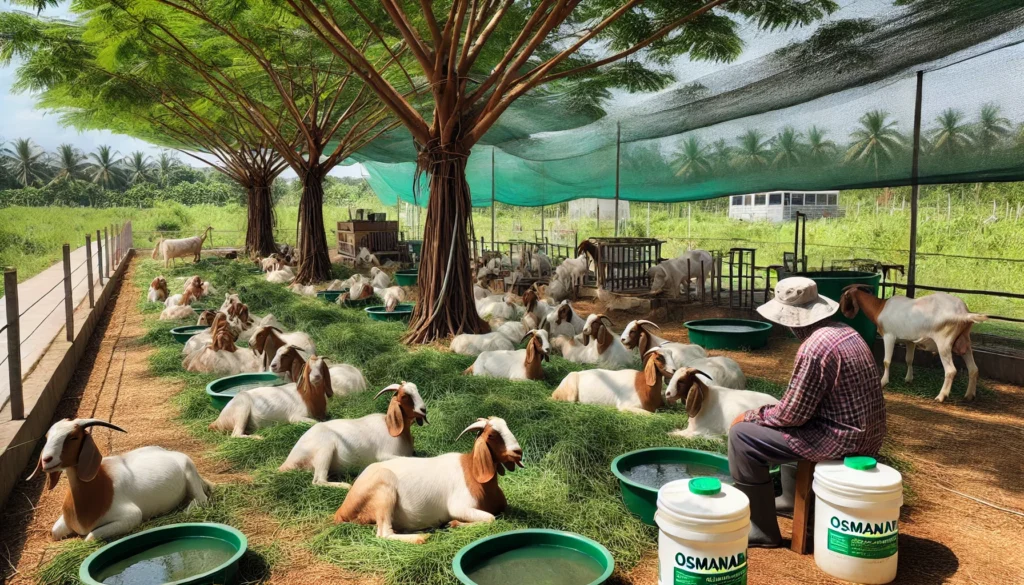
Mitigating heat stress on our farm involves a combination of proactive strategies. Here are some effective methods we can implement:
- Providing Adequate Shade: Ensure that goats have access to shaded areas during the hottest parts of the day. This can include trees, shade cloths, or specially designed osmanabadi goat shelter designs.
- Ensuring Fresh Water Supply: Clean and fresh drinking water should always be available. We must monitor water resources closely to ensure intake increases during heat stress.
- Diet Adjustments: Implement osmanabadi goat feeding strategies that include more succulent feeds, like fresh forages or high-moisture content foods, which can help with hydration and reduce heat stress reactions.
- Electrolyte Supplements: Use electrolyte supplements in their water to help balance any imbalances caused by excessive sweating and panting.
- Regular Health Checks: Keeping a watchful eye on our goats during hotter months is crucial for early detection of heat stress symptoms. Regular veterinary care and adherence to an osmanabadi goat vaccination schedule can bolster their overall health.
By understanding the effects of heat stress and adopting these management techniques, we can ensure that our Osmanabadi goats thrive even in challenging weather conditions.
Nutrition and Welfare Practices
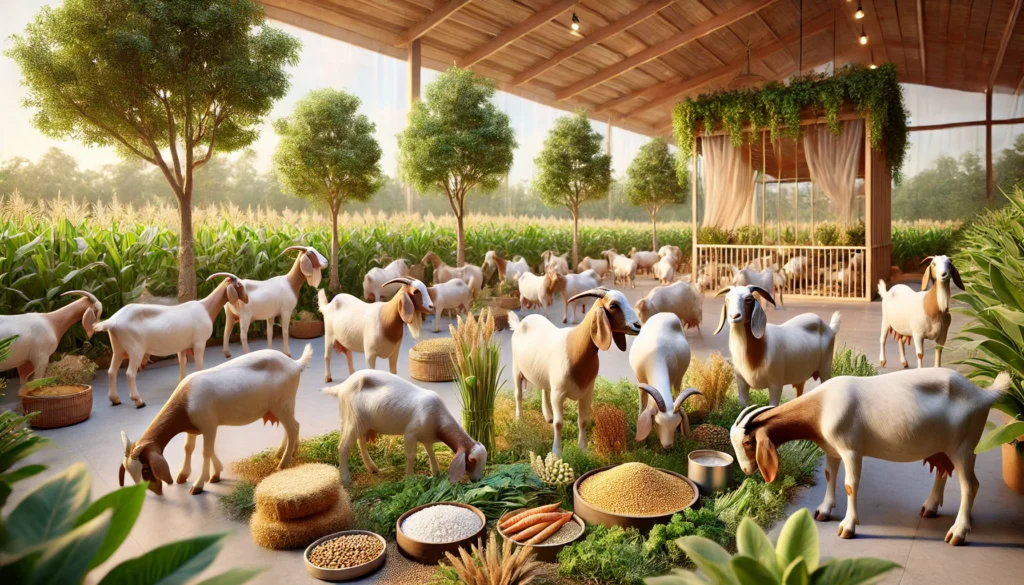
In order to ensure the health and productivity of our Osmanabadi goats, we must focus on providing appropriate nutrition and maintaining their welfare. These factors contribute significantly to their overall performance across different seasons.
Dietary Requirements
A well-balanced diet is crucial for the growth and productivity of Osmanabadi goats. Their diet can include a mix of feed sources such as tree leaves, grasses, root plants, grains, and various other plant materials. It is essential to ensure that our goats receive the right nutrients to support their health.
Here is a guide to the dietary components and their recommended percentage in the diet of Osmanabadi goats:
| Component | Recommended Percentage |
|---|---|
| Grasses | 40-60% |
| Legumes | 20-30% |
| Grains | 5-10% |
| Green Fodder | 10-20% |
| Mineral Supplement | 1-2% |
When formulating their diet, we must also consider the impact of heat stress. Goats in tropical regions often experience reduced growth performance due to heat stress, which can negatively influence milk and meat production. Ensuring a balanced diet helps mitigate some of these effects and supports overall productivity.
For more detailed feeding strategies, refer to our article on osmanabadi goat feeding strategies.
Environmental Considerations for Goat Welfare
Creating a suitable environment is vital for the welfare of our Osmanabadi goats. We should provide clean and comfortable living conditions, especially during hot weather periods. This includes proper shelter design and ventilation to help regulate their body temperature and prevent heat stress.
When designing shelters, we should keep the following in mind:
- Ventilation: Adequate airflow is essential to keep the goats cool and reduce their discomfort.
- Bedding: Use clean bedding to ensure cleanliness, which minimizes the risk of illness.
- Space: Goats need enough space to move around comfortably, which helps reduce stress and promotes social behavior.
Additionally, proper care during pregnancy is crucial. We must ensure a clean and comfortable environment for kidding to support both the mother and her kids. Access to fresh water and quality feed also allows goats to thrive.
By focusing on nutrition and welfare practices, we can create a conducive environment for our Osmanabadi goats to flourish. Proper dietary intake and thoughtful environmental conditions contribute to their overall health, ensuring that they remain productive throughout the seasons. Don’t forget to keep an eye on our osmanabadi goat vaccination schedule to safeguard their health effectively.

